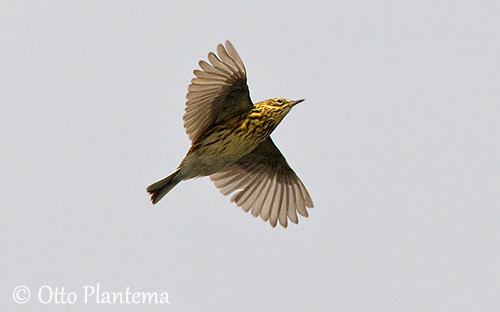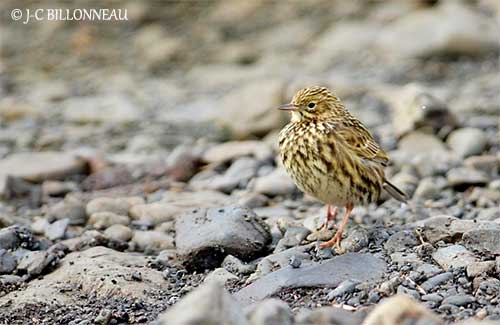
Fr: Pipit antarctique
Ang: South Georgia Pipit
All: Riesenpieper
Esp: Bisbita de Georgia del Sur
Ita: Pispola antartica
Nd: Zuid-Georgische Pieper
Sd: Sydgeorgisk piplärka
Photographers:
Jean-Claude Billonneau
Photographe-témoin de la Beauté du Monde
Otto Plantema
Trips around the world
Text by Nicole Bouglouan
Sources:
HANDBOOK OF THE BIRDS OF THE WORLD Vol 9 - by Josep del Hoyo - Andrew Elliot - David Christie - Lynx Edicions - ISBN: 8487334695
BirdLife International (BirdLife International)
Notes sur Anthus antarcticus - Murphy, R. C. 1923
South Georgia and South Sandwich Islands – Eradication of rodents
South Georgia Pipit
Anthus antarcticus
Passeriformes Order – Motacillidae Family
INTRODUCTION:
The South Georgia Pipit is one of the rare passerines nesting on South Georgia and small adjacent Islands. The major threat is the Norway brown rat (Rattus norvegicus) and also other rodents which are devastating the environment and have a catastrophic effect on the bird species because they eat both eggs and chicks.
The South Georgia Pipit is probably related and has possibly evolved from the Correndera Pipit (Anthus correndera). It formerly bred throughout this area but today, its population is evaluated as Near Threatened. The species is confined to predator-free islands and islets.
The SGHT – Habitat Restoration Project (South Georgia Heritage Trust) is working on rats and mice eradication from the entire island.
DESCRIPTION OF THE BIRD:
Biometrics:
Length: 16-17 cm
Wingspan: 23 cm
The adult has dark brown upperparts with pale feather edges making heavy scaled effect. On the upperwing, the feathers are edged pale buff and the wing-coverts have pale tips, forming a faint wingbar on the median coverts. The tail is darker, mostly blackish-brown, with greyish-white outer rectrices.
On the underparts, chin and throat are whitish. The rest of underparts are whitish with buff wash and heavy brown streaks on breast, belly and flanks, although central belly is more uniformly whitish.
The head is dark brown and finely streaked blackish-brown. We can see a faint buffy-white supercilium and eye area, but moustachial and malar stripes are blackish and conspicuous.
The bill is blackish with reddish base of lower mandible. The eyes are dark brown. Legs and feet are pinkish-grey. Like in all pipit species, the hind claw is longer than the others.
Both sexes are similar.
The juvenile resembles adult with more buff overall, and especially on the underparts.

RANGE:
The South Georgia Pipit is found in South Georgia, including mainland and offshore islets, in S Atlantic Ocean.
This species is endemic to South Georgia.
HABITAT:
The South Georgia Pipit breeds at low elevation in tussac grassland, often near streams and inland pools. It is often seen foraging on rocky shores among kelp.
During the austral winter, it can be seen along ice-free shorelines.
CALLS AND SONGS: SOUNDS BY XENO-CANTO
The South Georgia Pipit usually utters a twittering song in flight, and high-pitched series of calls. From the ground, it utters a shorter song with long intervals. When disturbed and flushed, it utters soft notes or a sharper “tzip”.
BEHAVIOUR IN THE WILD:
The South Georgia Pipit feeds both on insects and crustaceans, according to the habitat and the season. Insects are taken among tussac and dense grass among which the bird walks and runs over short distances. The thick grass provides the bird a good cover while searching for preys such as springtails, beetles, flies and spiders.
But it also forages along the shores in winter, when the snow is covering the usual grassy foraging sites. It takes small marine invertebrates among kelp and seaweeds, from which it picks food items while walking, stopping, flicking the tail, and running again.
During the breeding season, the male performs aerial displays. It flies into the air to some height, and then descends. This display is accompanied by song, while the raised wings and tail are vibrating. They are monogamous and nest on the ground among tall grass, or in rock crevices.
The South Georgia Pipit is resident in its range, but it moves to offshore islets during the breeding season, where predators are absent.
It has an agile, undulating flight.
REPRODUCTION OF THIS SPECIES:
The breeding season occurs between mid-November and January/February.
The South Georgia Pipit builds a bulky, deep, cup-shaped nest which is partly domed. It is made with rootlets and fine grass. The inner cup is lined with feathers. It is placed on the ground in dense grass tussock, and sometimes in rock crevice on the mainland.
The female lays 3-4, sometimes 5 greenish-brown eggs with darker markings. Little is known about incubation and nesting period. Both parents feed the chicks and remove the faecal sacs.
From some observations, the incubation period probably ends in January and lasts between 11 and 14 days, sometimes one or two days more. The nestling period is often similar, although the chicks may leave the nest sooner if disturbed. The young birds usually depend on parents for food for two or more weeks after fledging.
This species may produce two broods per season. The South Georgia Pipit, adult and chick, are sometimes taken by natural predators such as the Brown Skua (Stercorarius antarcticus lonnbergi), and by introduced brown rats.
PROTECTION / THREATS / STATUS:
The South Georgia Pipit is very vulnerable to predation by Rattus norvegicus, introduced in the early 1800s by sealers and whalers. But this bird occurs now on predator-free islands, and eradication of brown rats is under way. The species is extending progresssively its range, thanks to the control of introduced predators.
This species has restricted range. The small population is estimated at 3000/4000 pairs, equivalent to 6000/8000 mature individuals, and 9000/12,000 individuals in total. This population is currently stable.
However, the South Georgia Pipit is still evaluated as Near Threatened.
